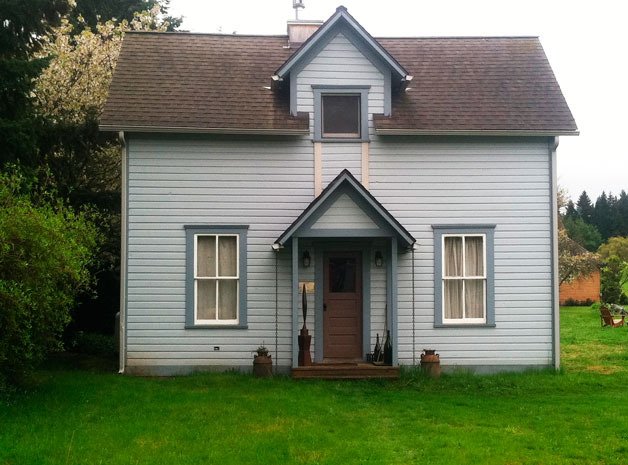Adam Voelker, who lived from 1863 to 1940, was a short, bow-legged man with crossed eyes and stained teeth, according to South Whidbey historian Lorna Cherry.
Voelker was a childhood friend of Langley founder Jacob Anthes from Gros Gerau, Germany and he followed Anthes to South Whidbey in 1888 to become his “building boss,” his superintendent of local projects.
Before collaborating with Anthes on Langley’s second dock at the foot of Wharf Street, Voelker erected a small, side-gabled house for himself at Third and DeBruyn in Langley that still stands today.
Voelker’s periwinkle house exudes a quiet appeal. It faces Third Street squarely, in characteristic rural fashion, a pristine example of American folk architecture. Called “the Prairie Schooner” by Langley locals in the 1980s, the home brings to mind midwest farmhouses that sit solidly on oceans of plowed fields.
Longtime Langley resident Fran Johnson remembers calling Voelker “Mr. Adams” in the 1930s. She says he wore a long coat that nearly swept the ground and that he had a special fondness for the daffodils that surrounded his house.
Voelker died Oct. 18, 1940. In 1941, Richard Luhn auctioned his estate, which included lots 1, 2, 19 and 20 of block 1 in Langley. Les and Nellie Arnold purchased all four lots for $450.
The Arnolds resold the lots a year later to Siegfried and Alice Stockholm, who had migrated from Nebraska via California to join their relatives, the Melsens, on South Whidbey. Like Voelker, Siegfried was a builder. He constructed the addition on the back of the Voelker house according to his niece, Kay Stockholm.
The Stockholms settled near Lone Lake, but Siegfried’s mother, Marie, and his sister, Louise, occupied the Voelker house until 1974. In that year, Siegfried left the property to Lulu Anderson, who died a month after inheriting it.
Her executor sold the lots to Brandt and Patricia Willson in 1974. Brandt’s family was from North Seattle, but had vacation property on Sunlight Beach. Edgecliff Drive resident Louise Prewitt recalls that ‘there was a big clallam’ with the city because Brandt Willson had pigs on the place to clean out the blackberry bushes.”
Brandt Willson verifies that his hogs, Roto and Rooter, did exceptional work at eliminating the blackberries, but that Mayor Manchester found them so offensive he passed a city ordinance banning pigs and swine. Since cows and horses grazed on his neighbors’ properties, Brandt Willson believed his pigs were unfairly singled out. He sued the city and won.
Brandt and Patricia, his brothers Kevin and Dennis, and his sister Mindy lived in the house. He remembers Richard Clyde’s surprise at learning they were all related.
“We thought you were a commune,” Clyde told him.
They built the adjoining structure in 1976. Kevin Willson lived upstairs, and all the siblings used the ground floor as a metal works studio.
“It was a good party house,” Brandt Willson remembers, but in 1979 the Willsons sold it and the studio to Harrison Jones and Deborah McDivitt to finance the Willsons’ move to the woods.
A mixed-media artist, Harrison taught art history and drawing at Cornish College of the Arts in Seattle. He met McDivitt, a self-described “country girl from South Jersey,” on a summer trip to Colorado. After living in Seattle’s Leschi neighborhood for two years, they relocated to Whidbey in 1980. Jones loved holidays, especially Thanksgiving. McDivitt remembers huge potlucks for 20-plus people spilling outdoors. They won the Langley Christmas decoration contest in 1986 by outlining the house, windows and roof in white lights, the bushes with red lights, and the fence in green. “We started decorating in October,” McDivitt said.
Kelley Choate, owner of downtown Langley’s Museo Gallery from 1996 through 2005, purchased the house from Jones and McDivitt in 1996. David Gignac bought the adjacent studio a few months later.
Adam Voelker’s house survives as a Langley landmark. An unbroken thread of craftsman/artist-owners enriched its history. It is an icon of an idealized America.


